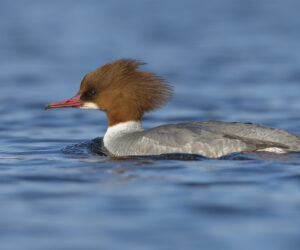A handsome, streamlined duck, goosanders are larger than mallards and belong to the sawbill family. Female goosanders are grey, with a white throat and a shaggy crest of longer feathers at the back of the reddish-brown head. Breeding drakes are white, with dark iridescent-green heads and black backs. Goosander have long red bills that are hooked at the end and widen closer to the face. When not in their breeding plumage (July-October), both males and females are usually grey, with a reddish brown head and a white chin.
Behaviour
Goosanders spend much of their time afloat, fishing and often sleeping on open water. They are among the very few ducks that catch fish for food, along with their ‘sawbill’ relatives, the red-breasted merganser and smew, all of which use the long, serrated bill for fishing. They have excellent vision and will hunt well into dusk, or even after dark. They often swim in small groups along the shoreline, dipping their heads and peering underwater to search for prey and then diving with a slight leap. They can stay under for up to two minutes, but they normally dive for less than 30 seconds. Although largely piscivorous (fish-eating), goosanders also eat molluscs, crustaceans, worms, insect larvae, amphibians, small mammals and birds.
Goosanders normally make their nests in a tree cavity, which is why they prefer inland habitats, often close to mature forests.
Size
- Length: 57-68cm
- Wingspan 82-97cm
- Weight: 9-2.1kg
- Average Lifespan: 7 years
Status
Classified in the UK as Green under the Birds of Conservation Concern 4: the Red List for Birds (2015). Protected by The Wildlife and Countryside Act 1981.
Distribution
Goosanders are most abundant in southern Scotland and much scarcer north and west of the Highland Boundary Fault. They are absent on the Shetlands, Orkneys and Outer Hebrides, but found in small numbers on the Inner Hebrides, including Mull, Arran and Bute.
When to see
All year round.
Facts
- Goosanders have a moult migration, yet extraordinarily, it is confined to the males. For many years, it had been noted that the drakes were absent from Scottish rivers from June to October, even where the mothers and broods were feeding. Their whereabouts remained a mystery until recently, when it has now been shown that the drakes travel a significant distance to northern Scandinavia.
- The salmon pink tinge that male goosanders often display in breeding plumage, is most likely related to their diet, which is high in orange or yellow pigments.
- The collective noun for a group of goosanders is a “dopping” of goosanders.

